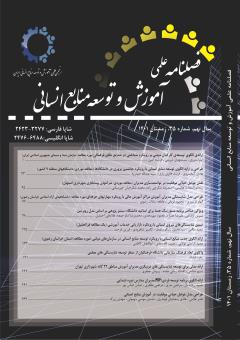ارائه الگوی جذب منابع انسانی با رویکرد توسعه منابع انسانی در سازمانهای دولتی (مورد مطالعه: استان خراسان رضوی)
محورهای موضوعی : روش های نوین آموزش وتوسعه منابع انسانیسعید کرامتی تولایی 1 , حبیب الله دعایی 2 , ابوالفضل کاظمی 3
1 - گروه مدیریت دولتی، واحد قزوين، دانشگاه آزاد اسلامي، قزوين، ايران
2 - موسسه آموزش عالی اسرار ، مشهد، ایران
3 - دانشگاه آزاد اسلامي، واحد قزوين، دانشكده مهندسي صنايع و مكانيك، گروه مهندسي صنايع، قزوين، ايران
کلید واژه: توسعه منابع انسانی, جذب منابع انسانی, سازمانهای دولتی,
چکیده مقاله :
این مقاله با هدف ارائه الگوی جذب منابع انسانی با رویکرد توسعه منابع انسانی در سازمانهای دولتی انجام گرفته است. پژوهش حاضر از نظر هدف، یک پژوهش کاربردی-توسعهای است و از منظر روش گردآوری دادهها، یک پژوهشهای پیمایشی-مقطعی قرار میگیرد. برای دستیابی به هدف پژوهش از طرح آمیخته اکتشافی استفاده شده است. جامعه آماری در بخش کیفی شامل مدیران با سابقه سازمانهای دولتی در استان خراسان رضوی است. نمونهگیری به روش هدفمند انجام شد و 15 نفر به اشباع نظری دست پیدا شد. جامعه آماری بخش کمی نیز شامل 6000 نفر از کارشناسان منابع انسانی سازمانهای دولتی است که با فرمول کوکران حجم نمونه 345 نفر برآورد گردید. با روش نمونهگیری چینهای در چهار منطقه از استان خراسان رضوی حجم نمونه مورد نیاز تامین شد. برای گردآوری دادهها از مصاحبه و پرسشنامه استفاده شد. مقولههای زیربنایی توسعه منابع انسانی با روش تحلیل مضمون شناسایی شد و الگوی نهایی با روش مدلیابی معادلات ساختاری اعتبارسنجی گردید. تحلیل دادههای کیفی با نرمافزار Maxqda و بخش کمی با LISREL انجام شد. نتایج نشان داده است مقولههای فراگیر در قالب عوامل فنی، انسانی و ارزشی دستهبندی شدهاند. عوامل سازماندهنده نیز شامل مهارت، دانش، نگرش، رفتار، پایبندی به ارزشها، عملگرا بودن، اقتصادی، تکنولوژیکی، اجتماعی، فرهنگی، انقلابی، مقتدر هستند. عوامل فنی از دانش، مهارت، عوامل اقتصادی و فناوری تشکیل شده است. عوامل انسانی شامل نگرش، رفتار، عوامل اجتماعی و فرهنگی است. در نهایت عوامل ارزشی نیز شامل پایبندی به ارزشها، عملگرا بودن، عوامل انقلابی و اقتداری است.
This article aims to provide a model of human resource absorption with the development of human resources in government organizations. In terms of purpose, the present study is an applied-developmental research and in terms of data collection method, it is a cross-sectional research. To achieve the research goal, a mixed exploratory design has been used. The statistical population in the qualitative section includes managers of government organizations in Khorasan Razavi province. Purposeful sampling was performed and 15 people achieved theoretical love. The statistical population also includes 6000 human resources of government organizations, which with the Cochran's formula is estimated at a sample size of 345 people. The required sample size was provided by stratigraphic sampling method in four regions of Khorasan Razavi province. Interviews and questionnaires were used to collect data. The basic categories of human resource development were identified by content analysis method and the final model was identified by validation equation modeling method. Qualitative data analysis was performed with Maxqda software and quantitative data with LISREL. The results of comprehensive categories are categorized in terms of technical, human and value factors. Organizing factors also include skill, knowledge, attitude, behavior, adherence to values, pragmatism, economic, technological, social, cultural, revolutionary, powerful. Technical factors consist of knowledge, skills, economic factors and technology. Human factors include attitudes, behaviors, social and cultural factors. Finally, value factors include adherence to values, pragmatism, revolutionary factors, and authority.


